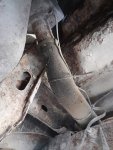Bronco648
Well-Known Member
- Joined
- May 23, 2019
- Messages
- 401
- Vehicle Year
- 2011
- Engine
- 2.3 (4 Cylinder)
- Transmission
- Automatic
- Tire Size
- 15"
OK, I'm getting close to having the my '85 RCLB re-assembled. However, because I didn't disassemble this truck, I'm a little lost as to how wiring and hoses are routed in the engine compartment.
First Question: How does the starter cable run to the starter?
I ran the red cable, from the starter relay, down and under the very front of the oil pan and then back to the starter along the driver's side of the oil pan. Is that correct?
Second Question: How does the ground cable run to the starter?
When I got my truck the ground cable was in poor condition so I replaced it with another 4 gauge cable that's ~2 inches longer. It originally had a brass Adele clamp that was soldered to the wire (sheath stripped) and the clamp was bolted to the outside of the frame just below the trailing edge of the battery tray. My Electrical & Vacuum Trouble Shooting Guide shows that a grounding cable goes to the bottom bolt of the starter (G104 for those with an E&VTSG). But the battery cable isn't long enough to reach the starter. Where does the negative battery cable go and how does it tie into the starter?
TIA
First Question: How does the starter cable run to the starter?
I ran the red cable, from the starter relay, down and under the very front of the oil pan and then back to the starter along the driver's side of the oil pan. Is that correct?
Second Question: How does the ground cable run to the starter?
When I got my truck the ground cable was in poor condition so I replaced it with another 4 gauge cable that's ~2 inches longer. It originally had a brass Adele clamp that was soldered to the wire (sheath stripped) and the clamp was bolted to the outside of the frame just below the trailing edge of the battery tray. My Electrical & Vacuum Trouble Shooting Guide shows that a grounding cable goes to the bottom bolt of the starter (G104 for those with an E&VTSG). But the battery cable isn't long enough to reach the starter. Where does the negative battery cable go and how does it tie into the starter?
TIA
Last edited:














